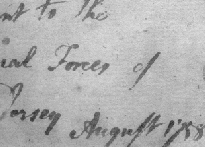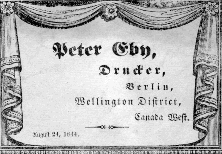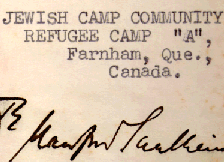




















|
|

Bibliophiles and book collectors are well known as lovers of the book as an object.
Few early Canadian book owners were bibliophiles, but since books were scarce and expensive, they were cared for, repaired, and passed on to the next generation.
The examples shown here demonstrate the many different ways in which copies were either transformed or personalized, and in other cases, how they were considered important enough to be taken as spoils of war or salvaged from a maritime disaster.

This book was owned by a resident of Fort Frontenac (Fort Cataraqui) and was part of the spoils which the troops of Major Bradstreet took after the surrender of the fort in August 1758. A manuscript note on the flyleaf reads as follows: "Taken among the spoils of Cataraghqui, & given to me, Mr. Bernard, Adjutant to the Provincial Forces of New Jersey, August 1758."
|

|
Heures de Nostre-Dame en français: A l'usage des enfans.
Bordeaux: Chez la veuve de J. De La Court..., 1748. 272 p.
|

Second Canadian edition of this important catechism. Copy from the library of Father Charles-Joseph Brassard Deschenaux (1751-1832), Catholic priest, seigneur, and important bibliophile whose library contained over 2000 volumes. Books being quite scarce in Canada during the 18th century, it was common practice to make manuscript copies of certain popular books. After the printed catechism, Deschenaux had bound a manuscript - dated 1772 - of the Cantiques spirituels sur les points les plus importans de la religion et de la morale chrétienne, a work which had often been reprinted in France during the 18th century.
From the library of Victor Morin.
Jean-Joseph Languet, 1677-1753
Catechisme du diocese de Sens.
Quebec: Chez Brown & Gilmore, 1766. 148, [3] p.

Contemporary red long-grained morocco binding, stamped with the name of Catherine-Louise Lovell, niece of seigneur Charles-Louis-Roch de Saint-Ours, and of Jacques Dorion (1797-1877), doctor and member of Parliament.
L'Office de la Semaine sainte et de celle de Pâque: En latin et en françois selon le missel et bréviaire romain. Nouvelle édition.
Québec: Imprimé à la Nouvelle imprimerie, 1816. 575 p.

On October 16, 1839, the barque Colborne, sailing from London to Quebec City, sank at the mouth of Chaleur Bay. According to a note from Henry W. Baldwin, sheriff of Gloucester (New Brunswick), this copy was part of the cargo found on the beach after the tragedy. It belonged to Elizabeth Field (1804-1890), wife of Peter Jones (1802-1856), Sauteux chief and Methodist minister, and had her name on the front cover of the binding "Elizabeth Jones alias Geje-uguumeegoa." Fortunately she had returned from England on another ship.
James Evans, 1801-1846 and George Henry, fl. 1837-1848
Nu-gu-mo-nun O-je-boa an-oad ge-ë-se-üu-ne-gu-noo-du-be-üng uoô Muun-gou-duuz gu-ea Moo-ge-gee-seg ge-ge-noo-ü-muu-ga-oe-ne-oug.
New York: Printed by D. Fanshaw, 1837. 392 p.

Very popular work which saw four editions from 1795 to 1804. The original binding was "repaired" and rebacked using a piece of leather sewn to the covers. Pieces of metal were fixed to the outside of the covers: a "house" binding. Copy of Michel Dumont, Rivière du Loup, in 1804.
Jean-Baptiste Boucher-Belleville, 1763-1839
Recueil de cantiques à l'usage des missions, des retraites, et des catéchismes. Troisième édition.
Québec: John Neilson, 1800. 338 p.

In early Canada, most bibles were imported from England or the United States. This family bible belonged to Thomas Molson (1791-1863), second son of John Molson, Sr. (1763-1836), founder of the business enterprises. It was given to Thomas by his father and contains this inscription on the title-page "Donum ab meo patre [signed] Thomas Molson." The first two blank leaves contain the birth and death dates of children from 1817 to the death of Thomas' wife Martha Molson in 1848. Later inscriptions in pencil bring the list up to Thomas' own death in 1863.
The Holy Bible, Containing the Old and New Testament...
London: George Eyre and Andrew Strahan, 1813

Calf binding with upper board extended into a curved flap fitting under a strap of the lower board. Copy belonging to Peter Eby with his lettered leather label on upper board and engraved bookplate: "Peter Eby, Drucker, Berlin, Wellington District, Canada West. August 24, 1844." Peter Eby, a son of bishop Benjamin Eby (1785-1853) and brother of printer Heinrich Eby, was the owner of several German-language newspapers during the 1850s and 1860s. A typical binding for a book designed to be carried in hand or lying flat, rather than being shelved.
|

|
Die gemeinschaftliche Liedersammlung, zum allgemeinen Gebrauch des wahren Gottesdienstes.
Berlin [Kitchener, Ont.]: Heinrich Eby, 1841. 395 p.
|

During World War II, Jews with German or Austrian citizenship were placed in internment camps in Canada. Mr. Schessinger, interned in a camp at Ile-aux-Noix, was called to Farnham to lead High Holiday services. In gratitude, the Jewish camp community gave him this book with an inscription signed by Dr. Manfred Saalheimer and Heinz Abrahamson.
|

|
Form of Prayers for the Feast of New Year with English Translation. Revised edition.
New York: Hebrew Publishing Company.
|

|
